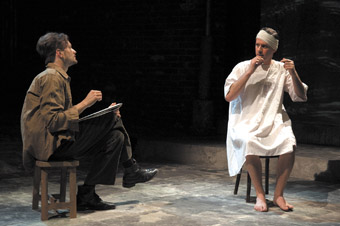murderous ambivalences
jonathan marshall: robert reid’s portraits of modern evil

Brendan Ewing, Thomas Papathanassiou, Portraits of Modern Evil
photo Gary Marsh
Brendan Ewing, Thomas Papathanassiou, Portraits of Modern Evil
THE MURDERS COMMITTED BY EDDIE LEONSKI—A US SERVICEMAN STATIONED IN MELBOURNE DURING WWII—INSPIRED THE MOVIE DEATH OF A SOLDIER (1985). WHILE THE ANTIPODEAN EXPRESSIONISTS’ SEXUAL PECADILLOS (ALBERT TUCKER, JOY HESTER, ET AL) HAVE RECEIVED BIOGRAPHICAL TREATMENTS,THEIR LIVES AT HEIDE FARM WITH PATRONS JOHN AND SUNDAY REED HAVE NOT PREVIOUSLY BEEN FICTIONALISED. ROBERT REID’S PLAY INVENTS AN ENCOUNTER BETWEEN LEONSKI, TUCKER AND THE LATTER’S THEN-WIFE HESTER (WHO SOON AFTER LEFT HIM AND THEIR CHILD) TO EXPLORE TUCKER’S FAMOUS IMAGES OF MODERN EVIL SERIES (1943-47).
As biographers like Janine Burke have found, the lives of Tucker and his circle were so melodramatic and widely commented upon (Tucker too abandoned his son to the Reeds, the hapless Sweeney later taking his own life) that the ego and psyche of these larger than life characters threatens to eclipse their output—especially given that Tucker and Hester described their paintings as expressions of their individualised perspectives on the world and society.
The fervid energies of wartime Melbourne were so intense, so overdetermined, so overwhelming and dynamically seductive that one empathises with Tucker for being agog in the face of such social and sexual turbulence, attracted by shafts of vivid green light shearing through a wartime metropolis alive with sojourning American soldiers desperate for a last touch of flesh; by the sight of local women partying with them as if their mortality depended on it; staring at those clawed, groping hands and rounded buttocks, and wondering if Tucker and his emasculated compatriots were right and that the whole city was engulfed by whoring. Or did everyone—Tucker included—simply crave the warmth of another body before youth, modernity or conflict ended it all?
The playwright faces a similar conundrum, veering between offering a thriller, an analysis of Tucker’s scarred, often misogynist psyche, or an abstract musing on war, sex, and the attraction of a world where everything has become, like Tucker’s paint, ‘stuff,’ meat, flesh, contact and ultimately deathly. The closing scene in which Leonski is about to escort an unconscious Tucker and a vulnerable Hester through the darkened streets draws the play into the realm of thriller, only to conclude there. Similarly the detail, taken from court records, that Leonski wanted to steal the voices of those he killed, is a false lead since the murderer’s psyche is only touched upon.
Given these narrative inconsistencies, the production is most effective when Tucker and the murdered women act as a poetic chorus. The language is especially apt here. Materials, objects, smells and perceptions are enumerated, yet their significance or what brings them together in terms of meaning or morality is left unspoken. Reid perhaps draws on other wartime commentators like Louis-Ferdinand Céline or Georges Bataille who render a world view aflame with the richness of base materials, colours, objects, forms and furs, but which sees in this meaningless litany of gorgeous “muck” (Céline’s preferred term) a terrifying loss of social cohesion, meaning and ethics; of a world reduced to one damn thing after another in which humans are no more important than the stuff of the soil or of the city. From reading Céline—an anti-Semite and sometime fascist collaborator—we know where this perspective can lead.
Reid offers his own critique in the penultimate scene where the deranged, provoked Tucker spews forth repressed vituperations against women and their sexuality for becoming complicit with this social condition, and eventually contemplates murder himself. As Janine Burke recently suggested to me, Tucker’s strength is as much in how explicit he is about his intense ambivalence towards women and sex, as it is in the formal qualities of his paintings. Like Céline, Tucker rarely hid behind social graces, his oeuvre making clear his love and lust for women, as well as his rages against them.
Director Adam Mitchell’s decision to project details from Tucker’s paintings onto the flanking corridors down which the chorus languidly strolls is particularly astute. The piece is as much about the texture of things as it is about the overblown lives of the Heide circle. Details like the rough, red bricks, the stained corrugated iron, and the frosted back window evoke that sensorial experience of a bleeding, partying city—Tucker’s greatest achievement. Reid and Mitchell combine this with more dramatic content than to my taste. The scene in which Tucker describes the wounds he painted during his brief military service in Mildura is a compelling moment in which these two strands—the dramaturgical and the sensorial—meld. With polishing, this production deserves to tour.
Black Swan HotBed Ensemble, Portraits Of Modern Evil, writer Robert Reid, director Adam Mitchell, performers Brendan Ewing, Ben Russell, Anita Erceg, Thomas Papathanassiou, Amanda Woodhams, Jo Morris, designer Brad Reid, lighting Andrew Earle, sound Kingsley Reeve, projection Sohan Hayes; PICA, Perth, Sept 4-20
RealTime issue #87 Oct-Nov 2008 pg. 14






